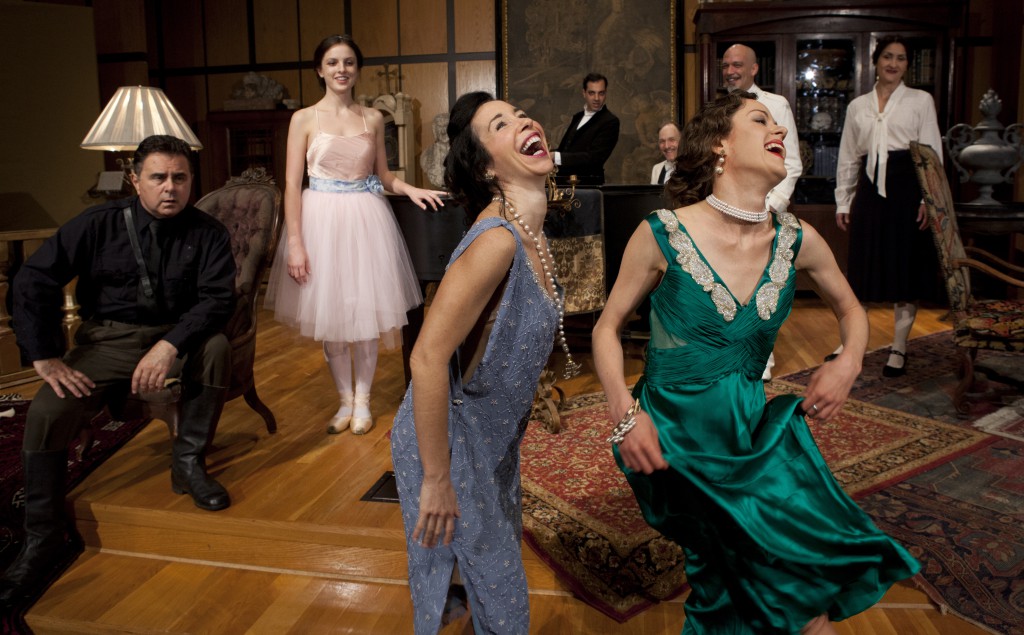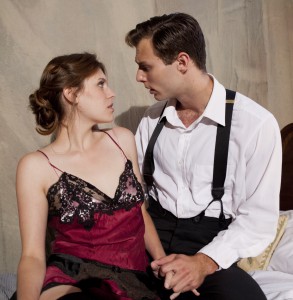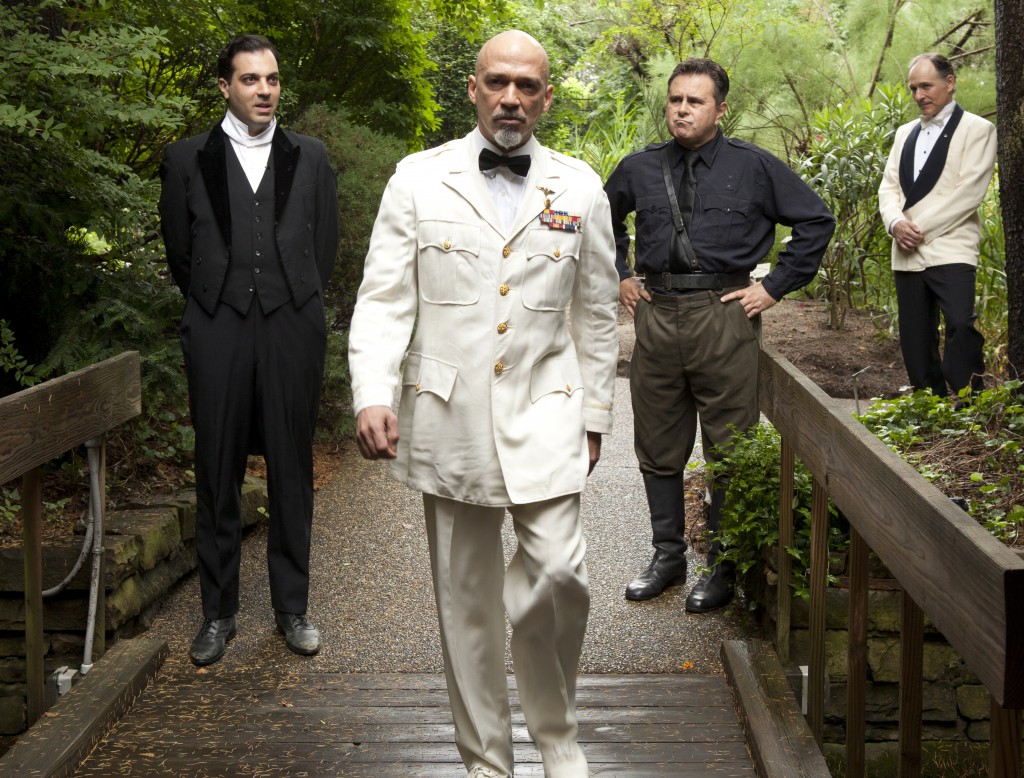Quantum’s ‘Tamara’: Dancing in a House of Intrigue While Rome Burns
There’s an old saying about a dog trained to dance on its hind legs: The marvel is not that it dances well, but that it dances at all. The same might be said of John Krizanc’s play Tamara—which is so difficult to produce that few theater companies even attempt it—except that the Pittsburgh production by Quantum Theatre does more than just get this massively tricky play off the ground. Quantum’s cast and crew make it dance like a team of whirling dervishes.

Tamara (Megan MacKenzie Lawrence, right front) promotes cultural exchange by teaching Luisa (Robin Abramson, center) how to shimmy.
Set in Fascist Italy in 1927, Tamara is a tragicomic, psychosexual political thriller. You’ve seen that basic kind of play or movie before, with every character entangled in a maze of hidden agendas and conflicting passions. The play is exceptional, though, because a new dimension has been added: The whole bundle is wrapped inside a theatrical experiment.
Tamara, which premiered in Toronto and had extended runs in L.A. and New York during the 1980s, was a pioneering work of immersive theater. It wasn’t written to be presented conventionally. The action unfolds through the rooms and corridors of an Italian villa—in the Pittsburgh production, part of the historic Rodef Shalom Congregation building has been redecorated to serve as the villa—and to follow the action, you must follow the actors.
The intent is to make theater feel more like real life. Much of the time, you are literally “immersed” in what’s going on. At one point during the performance, I entered a room, plopped into an armchair, and soon found myself in the middle of a dramatic confrontation. Two men were shouting back and forth above my head, pacing around so closely I had to keep my feet tucked in. Elsewhere, a couple of bedroom scenes were intensely intimate, and one was intimately absurd. The spectacle of a man trying to seduce a woman in a way that you know will fail becomes more ridiculous and hits closer to home when you’re watching the creep-out fail right in front of you.
This form of the art, however, imitates life in another crucial respect. Tamara has many stories in progress at once and you can’t be everywhere. What you see will depend on where you go. After the fireworks between the two men, I couldn’t follow the pair; they exited separately. So I tagged after a third character … which led to new adventures. But I wound up missing a number of things entirely, including a lesbian courtship, a subplot among members of the household staff, and a suicide.

When servants Emilia (Rachel McKeon) and Mario (Thomas Constantine Moore) meet below the stairs, they’d like to keep it on the up and up, but in this house anything may happen.
I heard about them afterward from my college-age daughter, who caught those parts, while my wife witnessed some but not all of the scenes that I did, and vice versa.
The marvel of the play (and of Quantum’s production) is that despite the disjointedness, it works. The three in my family group saw three different versions of Tamara, each a mélange of story fragments. Yet we never were left totally in the dark. On our own, we were able to make narrative sense of the versions we saw, and we each became thoroughly caught up in the performance.
Creating such an experience is hard for a theater company for several reasons. A big, suitable venue has to be obtained. For the actors and director, timing is a major issue, as a host of scattered mini-dramas have to stay in synch. The ballerina in Tamara can’t dance unless the piano player finishes a previous scene in time to be at the keyboard. A character who is operating undercover for Mussolini must juggle a variety of diverse appearances, revealing the right bits of the game at the right times.
And here is a striking aspect. Though Mussolini himself never appears, characters in Tamara are based on historical figures who, in some instances, really did what the play re-enacts.
Real People, True Stories
The artist Tamara de Lempicka (played by Megan MacKenzie Lawrence) was well known across Europe in the 1920s and ‘30s, both for her paintings and her flamboyant lifestyle. She really did visit the renowned Italian writer and military hero Gabriele D’Annunzio (Fermin Suarez), hoping to paint his portrait. Just as in the play, Tamara was, in fact, dismayed to learn that the great man was an incurable womanizer who’d invited her to his villa for purposes other than advancement of the arts. The real D’Annunzio did have a tempestuous relationship with the high-strung Luisa Baccara (Robin Abramson), and the Fascist regime did include a Jewish Blackshirt named Finzi (Robert Turano).

Do good guys wear white? D’Annunzio, the wartime leader known as “Il Comandante” (Fermin Suarez, front) thinks so. Dante, the valet (Ethan Hova, left), tactfully reserves judgment while Blackshirt Finzi (Robert Turano) and de Spiga (Ken Bolden) ponder the situation.
Moreover, to cite a fact that’s important to the development of the play, D’Annunzio—once a mentor and ally of Mussolini—really did live on the edge politically as well as sexually. After rising to power, Mussolini saw his old friend as a troublesome potential rival: too popular to get rid of and too popular to leave alone. So Mussolini kept the guy confined to his villa under the close watch of trusted Fascist minions like Finzi and assorted secret agents.
There in a nutshell is the setup for the drama. Much of the rest is fictionalized and can’t be summarized here because it is (a) loaded with spoilers and (b) too complicated anyway.
Learning to Love Tamara
Getting into the play as an audience member requires a bit of adjustment. With 10 characters interacting, it can be tough at first simply to keep track of who is who. One must also get used to traipsing about the villa in company with a bunch of other audience members. The good news is that one does get used to it. After a while, it doesn’t interfere with the reality or intimacy of the play. You can be crowded into a tight room with 20 or so spectators, and they’re practically invisible because you are locked in on the action. (It helps, too, that the total audience number is limited to 100 per show.)
And locking in on the action is very rewarding. Among the sharp cast, you may find certain actors and their characters becoming your favorites. I was particularly blown away by Ken Bolden as Gian Francesco de Spiga. De Spiga, an erstwhile classical musical composer, initially seems a mere throw-in to help move the stories along. But he’s more than a walking plot device, and as his personality fills out in shades of many colors, Bolden fills the role powerfully.
Then again, Tamara is a play about a spider-web of intrigue in which none of the characters are quite what they seem, and everybody is both predator and prey. All of Mussolini’s Italy seems to be waxing towards greatness, but is, in fact, on a path that will bring it down in flames.
Does the play carry messages and auguries for our own times? Given that Quantum Theatre has chosen to do it, you can bet your bottom dollar it does. It’s up to you to figure out what the meanings might be.
And speaking of dollars, the price of a ticket buys you a catered meal at intermission. In the lovely garden of the villa no less! So relax and enjoy. Like Tamara de Lempicka, you’re the guest of Italian aristocrats. Dance along with the fine folks who danced while Rome burned.
Closing Credits & Ticket Info
Tamara is directed for Quantum Theatre by John Shepard. Cast members not already mentioned are Cathryn Dylan as the anti-Semitic ballerina Carlotta Barra and Ethan Hova, Rachel McKeon, Thomas Constantine Moore, and Tammy Tsai as D’Annunzio’s household staff—all of whom are more than just a valet, a chauffeur, etc.
Rodef Shalom Congregation graciously allowed the use of its building. A veritable army of Quantum designers, staff, and supporters helped put the production together. Intermission dinners and refreshments are served each week by different caterers: Opening week was catered by e2 and Kate Romane Productions.
Tamara runs through Sept. 14 at 4905 Fifth Ave., Oakland. For performance dates, times, and tickets, visit Quantum or call 412-362-1713.
Photos courtesy of Quantum Theatre and Heather Mull.
Mike Vargo is a freelance writer and editor based in Pittsburgh.
Share on Social Media
Follow Entertainment Central
Latest Stories
Sign up for the EC Newsletter







